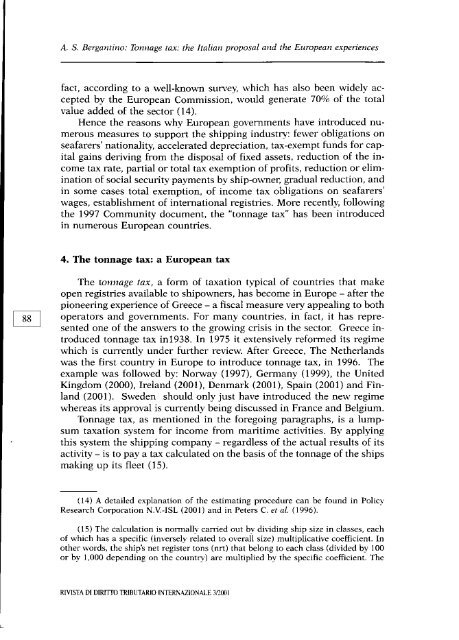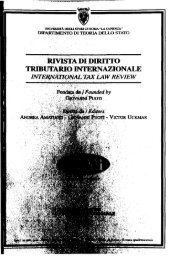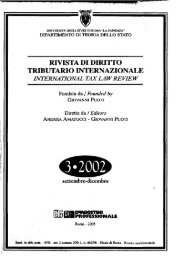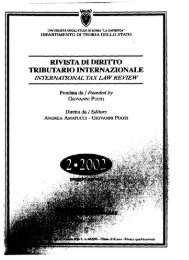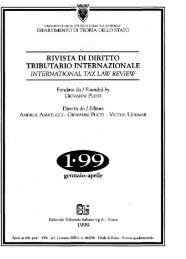RIVISTA DI DIRITTO TRIBUTARIO INTERNAZIONALE - Rdti.it
RIVISTA DI DIRITTO TRIBUTARIO INTERNAZIONALE - Rdti.it
RIVISTA DI DIRITTO TRIBUTARIO INTERNAZIONALE - Rdti.it
Create successful ePaper yourself
Turn your PDF publications into a flip-book with our unique Google optimized e-Paper software.
A. S. Bergantino: Tomzage tax: the Italial1 proposal and the European expenences<br />
fact, according to a well-known survey, which has also been widely accepted<br />
by the European Commission, would generate 70% of the total<br />
value added of the sector (14).<br />
Hence the reasons why European govemments have introduced numerous<br />
measures to support the shipping industry: fewer obligations on<br />
seafarers' national<strong>it</strong>y, accelerated depreciation, tax-exempt funds for cap<strong>it</strong>ai<br />
gains deriving from the disposal of fixed assets, reduction of the income<br />
tax rate, partial or total tax exemption of prof<strong>it</strong>s, reduction or elimination<br />
of social secur<strong>it</strong>y payments by ship-owner, graduai reduction, and<br />
in some cases total exernption, of incorne tax obligations on seafarers'<br />
wages, establishment of international registries. More recently, following<br />
the 1997 Commun<strong>it</strong>y document, the "tonnage tax" has been introduced<br />
in numerous European countries.<br />
4. The tonnage tax: a European tax<br />
The tmmage tax, a form of taxation typical of countries that make<br />
open registries available to shipowners, has become in Europe - after the<br />
pioneering experience of Greece - a fiscal measure very appealing to both<br />
operators and governments. For many countries, in fact, <strong>it</strong> has represented<br />
one of the answers to the growing crisis in the sector. Greece introduced<br />
tonnage tax in1938. In 1975 <strong>it</strong> extensively reformed <strong>it</strong>s regime<br />
which is currently under further review. After Greece, The Netherlands<br />
was the first country in Europe to introduce tonnage tax, in 1996. The<br />
example was followed by: Norway (1997), Germany (1999), the Un<strong>it</strong>ed<br />
Kingdom (2000), Ireland (2001), Denmark (2001), Spain (2001) and Finland<br />
(2001). Sweden should only just have introduced the new regime<br />
whereas <strong>it</strong>s approvai is currently being discussed in France and Belgium.<br />
Tonnage tax, as mentioned in the foregoing paragraphs, is a lumpsum<br />
taxation system for incorne from mar<strong>it</strong>ime activ<strong>it</strong>ies. By applying<br />
this system the shipping company - regardless of the actual results of <strong>it</strong>s<br />
activ<strong>it</strong>y - is to pay a tax calculated on the basis of the tonnage of the ships<br />
making up <strong>it</strong>s fleet (15).<br />
(14) A detailed explanation of the estimating procedure ean be found in Poliey<br />
Research Corporation N.V.-ISL (2001) and in Peters C. et al. (1996).<br />
(15) The calculation is normally carried aut by dividing smp size in classes, each<br />
of which has a specific (inversely related to overall size) multiplicative coefficient. In<br />
other \vords, the ship's net register tons (nrt) that belong to each c1ass (divided by 100<br />
or by 1,000 depending on the country) are multiplied by the specific coefficient. The<br />
<strong>RIVISTA</strong> <strong>DI</strong> <strong>DI</strong>RfITO <strong>TRIBUTARIO</strong> INTERKAZIONALE 312001


